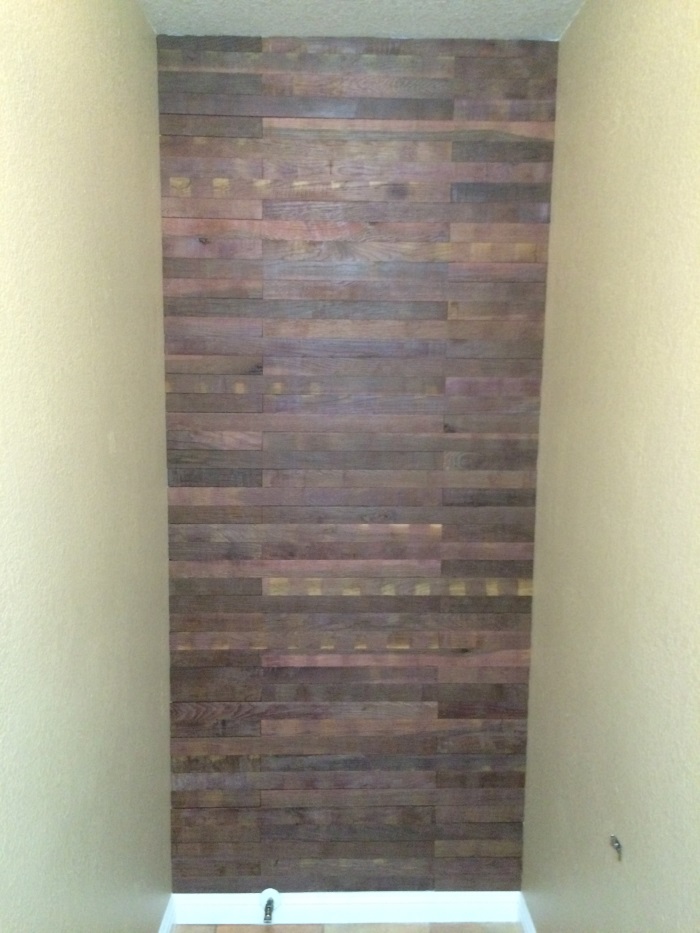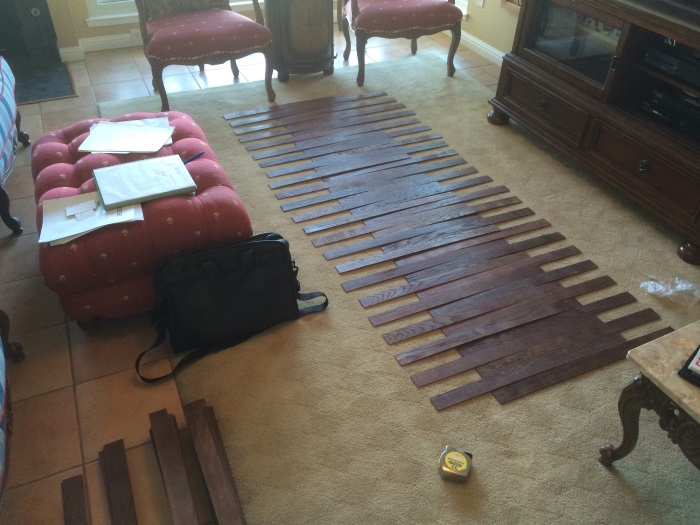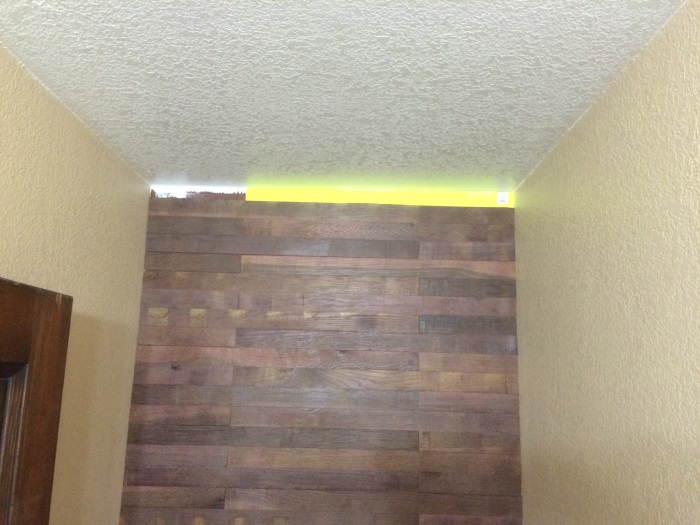Stikwood Wall

On a visit to New Orleans, my wife saw a friend's new house where she covered a bedroom wall using reclaimed wood from homes destroyed by Hurricane Katrina. She liked it so much, she wanted to do something similar at our house. She decided that we could redo one of our powder room walls. She found a product called Stikwood.
Stikwood is a thin strip of wood with adhesive backing. Since we are wine fans and live near Napa Valley, she selected Stikwood made from reclaimed wine barrels. Each piece of reclaimed barrel oak spent years playing an important part in the wine making process, and the complex colors and aromas are captured in the Stikwood.
Measure the Wall
Use a tape measure to determine the square footage of coverage required.
Order the Stikwood
The Stikwood stock comes in 16 square foot packages. Order enough to account for about 20% waste.
Paint the Wall

Paint the wall with a primer that is close to the color of the Stikwood. By doing so, if there are any tiny spaces between the Stikwood pieces, the exposed wall slivers will not stick out like a sore thumb. Make sure to completely cover the wall including the edges and all the way to floor and ceiling. The perimeter of the wall area is where the paint is needed the most.
Arrange on Floor

The on-floor arrangement allowed you to mix/match by swapping in pieces from among the packages. Do this until you are happy with the resulting variety.
Group Remaining Stock by Color

Grouping the remaining stock by color makes it easy to select a fill-in piece later. As each row is completed, a fill-in piece can be selected to provide variety to the row. The last thing you want is for your wall to look like one consistent piece of plywood. Varying the color of the pieces makes the patchwork come to life.
Snap a Level Line 1 1/2 Inches From the Top
The Stikwood instructions suggest that you snap a reference line, lay your first piece level, and then work up and down from there. Ignoring the directions, I tried starting at the very top, but the ceiling was not level. As a result, my strategy was to follow the directions and start about one and a half inches from the top, so I could custom trim pieces for the top row. I knew that cutting a 2-inch Stikwood piece to 1-and-one-half-inches ensured that enough backing adhesive would still be on the piece.
Apply a Full Stikwood Piece
Add a full 30-inch piece by removing the backing paper (which exposes the adhesive) and sticking it to the wall.
Cut a Stikwood Piece to Fit
Grab another 30-inch strip
Add blue tape to its face at around the correct length.
Hold the piece up to the wall and mark the exact length needed with a pencil.
Use a T-square to mark a straight line on the blue tape.
Cut the piece to its proper length using a jigsaw.
The blue tape helped keep the face from splintering when cut. The cut piece has no pencil mark since that was done on the blue tape.
Apply the Cut Piece to Finish the Row
Before removing the backing, hold the cut piece up and make sure the fit is good
Remove the backing tape and apply to the wall.
At first I tried to make the pieces fit exactly. Cutting a piece too long caused it to bow and not adhere to the wall. Cutting a piece too short left a gap between the adjacent piece or the edge near the wall. Eventually I decided that a little bit of gap between pieces actually highlights the patchwork. The wall behind the space has already been painted, so it blends in quite nicely.
Repeat steps 7 through 9 until only teh top and bottom rows remain.
Create Templates for Top and Bottom Rows

Cut the poster board (ours was yellow) to approximately the right side. Leave about an extra inch to be safe. Align the straight edge of the poster board with the top-most (or bottom-most) row and push into place. This makes a crease that can then be traced with a pencil. Apply blue tape to a piece of Stikwood. Use the template to trace the pattern on a the piece.
Cut Stikwod Pieces for Top and Bottom Rows
It took a few tries, but I eventually cut a piece to fit. For example, my first piece had a knot that caused it to split. When reducing pieces in width, pick ones without knots.
Use a Roller to Ensure All Pieces Are Secure
To make sure all of the pieces are secure, go over them with a foam roller.